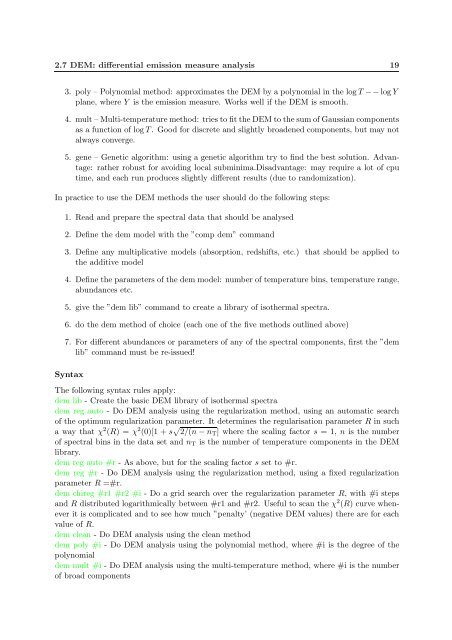SPEX User's Manual - SRON
SPEX User's Manual - SRON
SPEX User's Manual - SRON
Create successful ePaper yourself
Turn your PDF publications into a flip-book with our unique Google optimized e-Paper software.
2.7 DEM: differential emission measure analysis 19<br />
3. poly – Polynomial method: approximates the DEM by a polynomial in the log T − − log Y<br />
plane, where Y is the emission measure. Works well if the DEM is smooth.<br />
4. mult – Multi-temperature method: tries to fit the DEM to the sum of Gaussian components<br />
as a function of log T. Good for discrete and slightly broadened components, but may not<br />
always converge.<br />
5. gene – Genetic algorithm: using a genetic algorithm try to find the best solution. Advantage:<br />
rather robust for avoiding local subminima.Disadvantage: may require a lot of cpu<br />
time, and each run produces slightly different results (due to randomization).<br />
In practice to use the DEM methods the user should do the following steps:<br />
1. Read and prepare the spectral data that should be analysed<br />
2. Define the dem model with the ”comp dem” command<br />
3. Define any multiplicative models (absorption, redshifts, etc.) that should be applied to<br />
the additive model<br />
4. Define the parameters of the dem model: number of temperature bins, temperature range,<br />
abundances etc.<br />
5. give the ”dem lib” command to create a library of isothermal spectra.<br />
6. do the dem method of choice (each one of the five methods outlined above)<br />
7. For different abundances or parameters of any of the spectral components, first the ”dem<br />
lib” command must be re-issued!<br />
Syntax<br />
The following syntax rules apply:<br />
dem lib - Create the basic DEM library of isothermal spectra<br />
dem reg auto - Do DEM analysis using the regularization method, using an automatic search<br />
of the optimum regularization parameter. It determines the regularisation parameter R in such<br />
a way that χ 2 (R) = χ 2 (0)[1 + s √ 2/(n − n T ] where the scaling factor s = 1, n is the number<br />
of spectral bins in the data set and n T is the number of temperature components in the DEM<br />
library.<br />
dem reg auto #r - As above, but for the scaling factor s set to #r.<br />
dem reg #r - Do DEM analysis using the regularization method, using a fixed regularization<br />
parameter R =#r.<br />
dem chireg #r1 #r2 #i - Do a grid search over the regularization parameter R, with #i steps<br />
and R distributed logarithmically between #r1 and #r2. Useful to scan the χ 2 (R) curve whenever<br />
it is complicated and to see how much ”penalty’ (negative DEM values) there are for each<br />
value of R.<br />
dem clean - Do DEM analysis using the clean method<br />
dem poly #i - Do DEM analysis using the polynomial method, where #i is the degree of the<br />
polynomial<br />
dem mult #i - Do DEM analysis using the multi-temperature method, where #i is the number<br />
of broad components

















